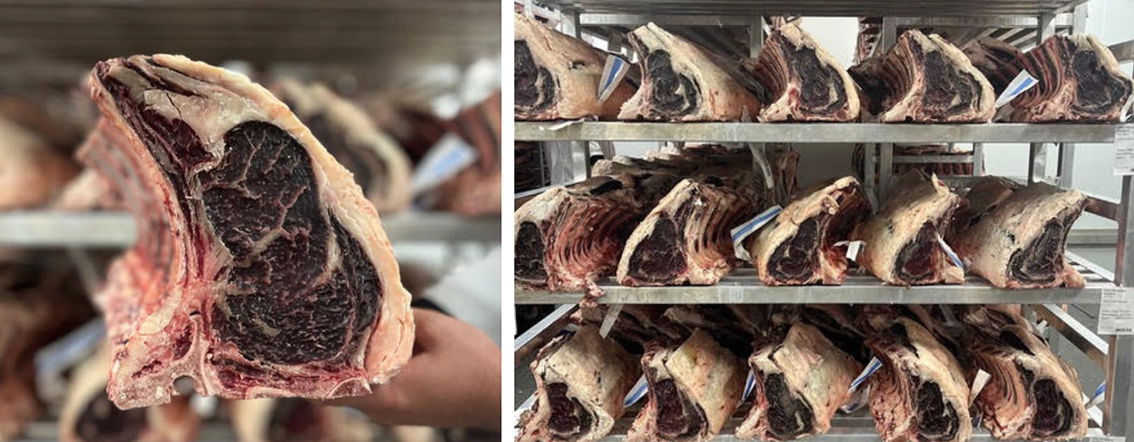DRY AGEING BEEF
DRY AGEING BEEF
The term Dry Aged is often overused and yet not fully understood. I would like to shine a light into that sometimes-misused term and hopefully give you a greater understanding.
I have seen examples where the opposite, wet aged meat (left to age in a vacuum bag) has been opened and left in an ageing chamber and given the name 'dry aged.' The result is simply not the same. I recently interviewed Simon Smith from Aubrey Allen the country’s (if not the world’s) leading catering butchers, to help explain what the process involves. They have been operating since 1933 and are still a family run business.

What is Dry Ageing?
Dry ageing is a process of tenderising meat and concentrating flavour by reducing moisture under strict controlled conditions.
What conditions are controlled?
There are three main conditions to control:-
1. TEMPERATURE
Temperatures are around 1-2C. Too cold and ice crystals form in the meat. Too warm and the outside becomes sticky and not dry.
2. HUMIDITY
Controlling Humidity is used to reduce moisture. Aubrey Allen is amongst the world leaders in dry ageing, they have engaged with many professors of animal science from all over the world and one thing they all agree on is that salt blocks whilst they look pretty, they have no effect on the eating quality of the meat. Instead, Aubrey Allen uses scientific controls over time in individual chambers, they keep their % a secret! But my research shows in other places it’s normally around the 80% mark.
3. AIR-FLOW
This is dependent on load. The bigger the load the more moisture is present. Large loads need a stronger airflow. Also, it is important to have allowed sufficient air to get around the chamber and between the meat.

What sort of cuts can be aged?
Whole muscle groups with fat coverage and on the bone. Primal Steak cuts are usually aged as whole rump and loin as are whole ribs. The “nutty” flavour promoted by dry ageing comes through the fat. Fat stays dry. The dark unpleasant darkening and hardening on the outside of the meat is trimmed away (this can be used as flavouring etc.) We want the brighter coloured red meat in the center. The nutty aroma is already inside this meat and this red fresh-looking meat will caramelise easily compared to the dark outside.
What cuts are not suitable?
Cuts that are going to be slow cooked (Braised / stews /marinated) or have the fibres dispersed are generally not dry aged, or cuts with no fat on the outside as the meat will go sticky.
With the concentrating of the flavour, is there any weight lost on the beef? Yes. Approximately 12% loss. Aubrey Allen tracks the weight of each whole piece before and after ageing, so with the time and weight loss tracking, it’s an expensive process, but more than worth it for the amazing results.
How long should beef be dry aged for?
This question has been scientifically answered. Optimum is 28 to 35 days. Let me explain further. The beef is measured by three tests. Tenderness, juiciness and flavour.
Tenderness
This is measured by testing cooked pieces of steak at differing ages. Cooked in temperature-controlled environment (sous vide) then put in a shear force instrument to measure its tenderness. The lactic acid in the muscles plateaus after ageing for 28 days. Experiments show after 40 days the same muscle becomes firmer.
Juiciness (or moisture)
The “drip” or evaporation peaks at 28 days. More than this and it becomes gradually dryer.
Flavour
This can be very subjective. Whilst tenderness increases and then decreases with time, flavour just continues to build. It is difficult to be accurately measured but taste tests are done on customers. Different countries have different tastes. In the UK again beef at 28 days proved to be most favorable. Beef taken much further got negative feedback with comments like “gamey, livery or Ox-like”

Notes on dry ageing other species
Dry ageing is open and uncovered. Species should never be mixed in the same dry ageing chamber. Each species of animal has differing rancidity levels and airborne spores and can cause cross contamination.